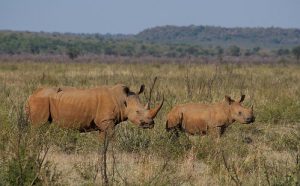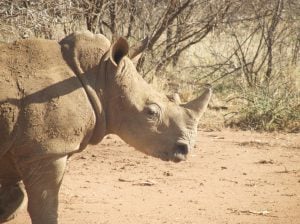China is steadily becoming a more popular destination for illegal rhino horn shipments from South Africa, warn experts, after Chinese customs officials report a major increase in horn seizures.
“The rhino horn trade in China is more active than previously recognised and needs to be assessed more deeply,” said the international wildlife trade monitoring organisation Traffic earlier this year.
Vietnam is emerging as one of the major drivers behind rhino horn trafficking. According to Traffic, nearly two-thirds of illegal rhino horn was shipped to Vietnam, while the rest was believed to be consumed in China.
In January 2013 three suspects, including a Vietnamese national, were caught smuggling 14 rhino horns from Vietnam to China, along with 55.53 kilogrammes of ivory, a tiger skin and a tiger skeleton.
Monitoring data from Traffic also shows that since 2013 China has made a series of seizures at the Vietnamese border.
“Traffic has also received information from Vietnam and Laos that indicated that rhino horns imported to these countries are re-exported to China,” said Tom Milliken who leads the elephant and rhino unit at Traffic.
An ongoing investigation in Vietnam by Interpol and conservation activists also recorded Chinese clients buying rhino horns and rhino horn products in a shop that predominantly deals with Chinese customers. The shop owner even provides a routing delivery service from Hanoi to China to avoid risk for buyers.
Diverse trafficking routes
The trafficking routes of rhino horns seized on their way into China vary in every case. Poached in Southern Africa, the rhino horns may be shipped in cargo holds from Cape Town or Maputo. They may also be transported to other African countries like Nigeria first and then shipped among timber or agricultural products to China. In other cases horns have been mailed or shipped to North America or Europe, and then flown on to China.
“Mailing and cargo holds are the two main channels for rhino horn smuggling into China. The horns can also be transferred among large amounts of ivory,” said Wan Ziming, China’s national coordinator of enforcement for the Convention of International Trade in Endangered Species.
Traffic cites a case involving a Thai national who confessed to smuggling a total of 300 kilogrammes of rhino horn on 15 occasions through the O.R. Tambo international airport in Johannesburg, often using Thai International Airlines. The horns were packed in personal check-in baggage, which was reportedly routed to Bangkok, then on to Laos, and finally to China.
In Southeast Asia, cross-border smuggling of horns from Myanmar and Vietnam into China has also been recorded.
With regard to Asia’s small and dwindling rhino populations, information gathered from interrogations of arrested poachers and traders, showed that the major trade route for rhino horns from South Asia was from Assam to Kathmandu in Nepal, via Siliguri or Kakarbhita, and then on to the Tibetan Autonomous Region with the ultimate destination being other cities in China.
Chinese smuggling groups have been caught using the United States as a trafficking stop. In February 2012 police arrested a group of seven alleged smugglers at Los Angeles airport. The leader was a Chinese national named Jin Zhao Feng, who faces charges of attempting to smuggle 12 rhino horns to China.
In February 2013, two Chinese nationals were accused of smuggling rhino horn from the US to Hong Kong and mainland China, one of whom stands accused of smuggling 20 rhino horns during 2011 and 2012.
More traffic?
Statistics from Traffic show that China accounted for an estimated two-thirds of the number and weight of horns seized in Asia between 2009 and September 2012. Thirty seizures of 67 rhino horns weighing 151.93 kilograms were documented. Over the same period only six seizures were recorded in Vietnam, involving 27 rhino horns weighing 70.86 kilograms.
Hong Kong has emerged as a major conduit in the rhino horn trade to China. In November 2011, a new record was set when customs seized 33 rhino horns and a large amount of ivory chopsticks and bracelets in a ship from Cape Town. Although the customs authorities refused to disclose the final destination, Tom Milliken said the rhino horns were most likely bound for Guangdong province.
Wan admits that there had been seizures of smuggled rhino horn in China every year since the government officially banned the trade in 1993, but he had not noticed a significant increase in seizures over the years.
“The number of rhino horns seized in all these cases is not proportional to the number of rhinos poached in South Africa,” he added.
Wan pointed out that officials in China scan all mailed packages, bulk cargo and shipping containers coming into the country, which is the reason that China leads in seizure numbers across Asia.
A source from Chinese customs argues that only a few seizures were made by customs of rhino horn. The reason might be that rhino horns are easy to hide from scans by customs, or because the actual trafficking amount is less than estimated.
Tom Milliken agrees that increasing seizure numbers reported by Chinese authorities demonstrates very good law enforcement, but it also indicates a greater traffic in rhino horn these days.
Susie Watts, an independent environmental policy researcher, said, “It’s too early to tell what will happen next in China. The signs are not good, though. A lot of rhino is going into China."
This story was supported by the Oxpeckers Center for Investigative Environmental Journalists and the Wits China-Africa Reporting Project.







